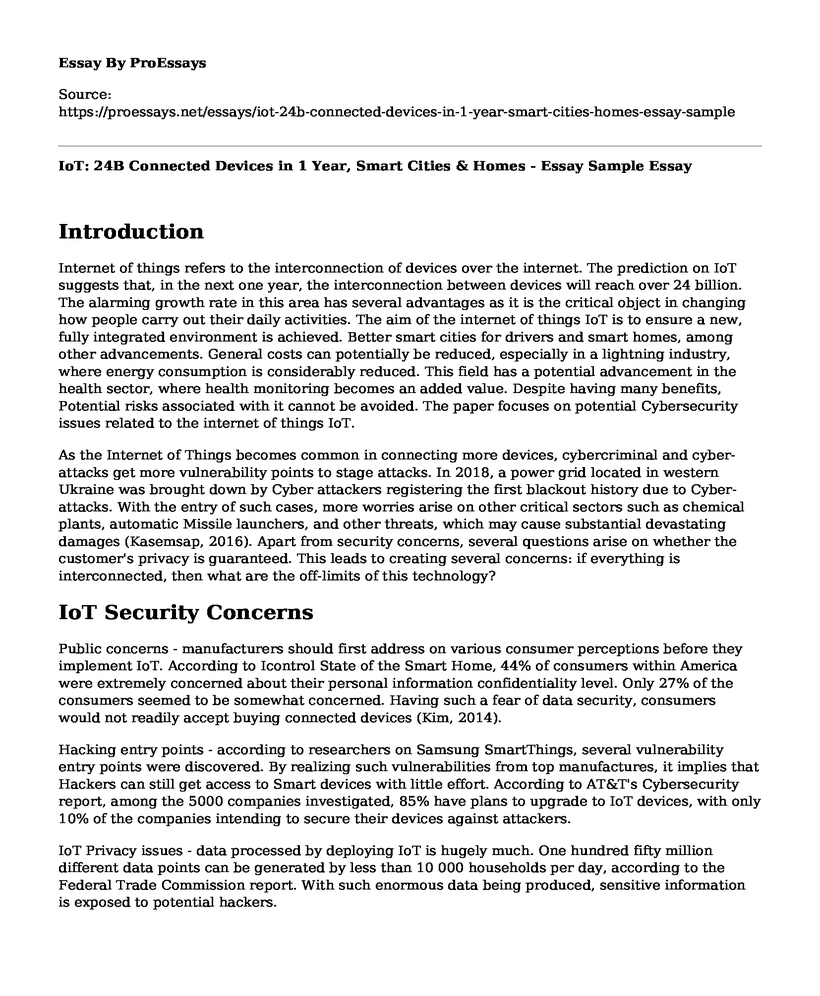Introduction
Internet of things refers to the interconnection of devices over the internet. The prediction on IoT suggests that, in the next one year, the interconnection between devices will reach over 24 billion. The alarming growth rate in this area has several advantages as it is the critical object in changing how people carry out their daily activities. The aim of the internet of things IoT is to ensure a new, fully integrated environment is achieved. Better smart cities for drivers and smart homes, among other advancements. General costs can potentially be reduced, especially in a lightning industry, where energy consumption is considerably reduced. This field has a potential advancement in the health sector, where health monitoring becomes an added value. Despite having many benefits, Potential risks associated with it cannot be avoided. The paper focuses on potential Cybersecurity issues related to the internet of things IoT.
As the Internet of Things becomes common in connecting more devices, cybercriminal and cyber-attacks get more vulnerability points to stage attacks. In 2018, a power grid located in western Ukraine was brought down by Cyber attackers registering the first blackout history due to Cyber-attacks. With the entry of such cases, more worries arise on other critical sectors such as chemical plants, automatic Missile launchers, and other threats, which may cause substantial devastating damages (Kasemsap, 2016). Apart from security concerns, several questions arise on whether the customer's privacy is guaranteed. This leads to creating several concerns: if everything is interconnected, then what are the off-limits of this technology?
IoT Security Concerns
Public concerns - manufacturers should first address on various consumer perceptions before they implement IoT. According to Icontrol State of the Smart Home, 44% of consumers within America were extremely concerned about their personal information confidentiality level. Only 27% of the consumers seemed to be somewhat concerned. Having such a fear of data security, consumers would not readily accept buying connected devices (Kim, 2014).
Hacking entry points - according to researchers on Samsung SmartThings, several vulnerability entry points were discovered. By realizing such vulnerabilities from top manufactures, it implies that Hackers can still get access to Smart devices with little effort. According to AT&T's Cybersecurity report, among the 5000 companies investigated, 85% have plans to upgrade to IoT devices, with only 10% of the companies intending to secure their devices against attackers.
IoT Privacy issues - data processed by deploying IoT is hugely much. One hundred fifty million different data points can be generated by less than 10 000 households per day, according to the Federal Trade Commission report. With such enormous data being produced, sensitive information is exposed to potential hackers.
Unwanted Public profile - FTC report indicates that sensitive information given by customers while visiting these companies can be used by organizations to make their own employment decisions. Most vulnerable areas which can be likely affected in such cases include insurance companies. Such cases can be done against customers' wish hence exposing customers' behaviors to potential hackers (Panda, 2017).
Eavesdropping - hackers may use connected devices to launch a virtual invasion to individual smart homes. A successful test was carried out by a German researcher who intercepted unencrypted data from a smart device to determine a show someone was watching (Zhu, 2019).
Despite IoT having many benefits, problems arising from connected devices could create a potential dent in future customers' desires to purchase connected devices, which may later hinder the Internet of Things from fully achieving its dreams.
References
Kasemsap, K. (2016). Internet of Things and Security Perspectives. Security Breaches and Threat Prevention in the Internet of Things, 19-45. doi:10.4018/978-1-5225-2296-6.ch002
Kim, J. T. (2014). Security and Privacy Issues of Element Technologies on the Internet of Things. doi:10.14257/astl.2014.64.13
Panda, S. (2017). Security Issues and Challenges in the Internet of Things. The Internet of Things, 189-204. doi:10.4018/978-1-5225-1832-7.ch009
Zhu, L., Gai, K., & Li, M. (2019). Security and Privacy Issues in the Internet of Things. Blockchain Technology in the Internet of Things, 29-40. Doi: 10.1007/978-3-030-21766-2_3
Cite this page
IoT: 24B Connected Devices in 1 Year, Smart Cities & Homes - Essay Sample. (2023, Mar 13). Retrieved from https://proessays.net/essays/iot-24b-connected-devices-in-1-year-smart-cities-homes-essay-sample
If you are the original author of this essay and no longer wish to have it published on the ProEssays website, please click below to request its removal:
- Fracking and the Impacts Essay Example
- Internet of Things Security Issues Essay Example
- Essay Example on Robots Dreaming of Human Life: Philip K. Dick's Do Androids Dream
- Maximizing Solar Resource Availability for Sustainable Energy Generation - Essay Sample
- Research Paper Sample on The Year 2000: A Significant Period of Global Change and Technological Advancements
- Essay Example on Securing Digital Data: Cybersecurity Strategies and Tactics
- Cell Phone Revolution - Free Essay Sample







